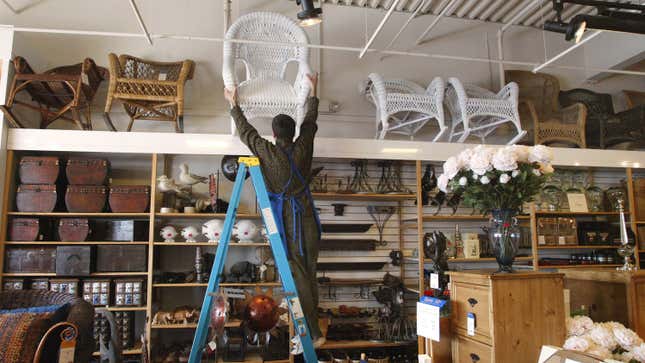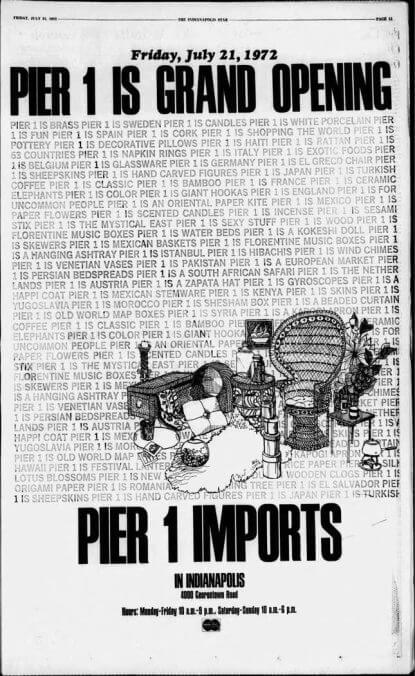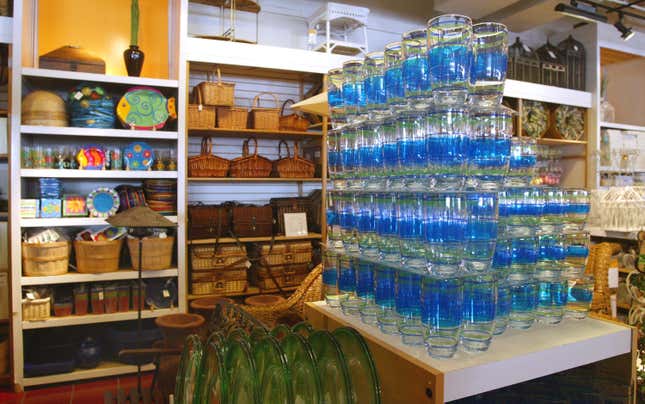Goodbye Pier 1, the Imperialist Fantasia Rendered in Wicker
In Depth

On July 21, 1972, the Indianapolis Star ran a full-page ad for the grand opening of the local Pier 1 Imports. It was a simple line drawing of items that might kit out a rec room or the corner of a suburban den: a rattan peacock chair sits at the center, surrounded by a wicker side table, tropical plants, and, inexplicably, a fondu pot. Sumptuous textiles spill out of a wicker trunk. A round terrarium sits on top of a sheepskin rug, near a precarious stack of baskets. The scene is homey, comfortable, redolent of incense and maybe marijuana. The copy that accompanies the ad is to the point—a run-on sentence comprised entirely of declarative statements of identity. “PIER 1 IS for UNCOMMON PEOPLE,” reads a section. “PIER 1 IS A HAPPI COAT PIER 1 IS KENYA PIER 1 IS A ZAPATA HAT,” reads another, a dizzying word salad that perfectly conveys the target demo for Pier 1, a young professional interested in dabbling in the hippie counterculture via informal home decor with an international vibe. Pier 1 quickly became synonymous with boomers still picking flowers to put in their hair, clinging to the dregs of the Summer of Love, its aesthetic ubiquitous and successful for four decades. But in May, Pier 1 Imports announced that its remaining 450 retail stores would close, after filing for Chapter 11 bankruptcy in January.
Liquidation has already begun, with shoppers welcome to scoop up hand-blown margarita glasses and decorative bowls by the armful. Pier 1 has been floundering for years, losing ground in a retail space increasingly dominated by e-commerce and marketplaces like Etsy and World Market, where consumers can find a robust selection of the vaguely “ethnic” offerings in which Pier 1 specialized.

But in the 1960s, Pier 1 was new, different, and exciting, the product of a very specific cultural moment. The first store was opened in 1962, in San Mateo, California, under the name “Cost Plus Imports”; the company’s own history says their first customers “were post-World War II baby boomers looking for beanbag chairs, love beads and incense.” By 1966, however, the company was headquartered in Fort Worth, Texas, and had grown to several stores across the country, still selling items that wouldn’t have been out of place in a head shop or flea market, like beaded curtains and rattan as far as the eye can see. Consider the Papasan chair, a staple of student apartments, boho decorating schemes, and arguably Pier 1’s most influential product. A thorough history of the chair over at Atlas Obscura explores the nebulous origins of this item, pinpointing its popularity specifically to that first store, which opened in 1962 as an emporium for vaguely exotic wares promising to communicate a sense of multiculturalism and worldliness. The precise origins of the chair itself are still murky, but it seems they were a staple in households in the Philippines and made it to the United States thanks in part to the efforts of Pier 1 in the late 1960s.
The first shoppers at Pier 1 Imports in San Mateo and the stores that followed weren’t necessarily all true hippies, but the store offered a watered-down version of that subculture, for baby boomers drawn to the informality of the counterculture, attracting an audience looking to move away from Grandmother’s chifforobe and towards, say, a natty rattan bedroom set. Pier 1 represents the mainstreaming of hippie aesthetics alongside boomers’ rejection of the staid, stuffy furnishings of their parents’ generation. A Pier 1 Imports store was selling a more casual, and less fussy lifestyle than other options on the market. Buying a solid wood sideboard from Ethan Allen and then filling the sideboard in the formal dining room with fine bone china conveys a formality that the boomer generation rejected outright. Pier 1 was a one-stop-shop for home decor that felt unique and gestured towards a life full of far-flung international travel, echoing the “hippie trail” in the ’60s and ’70s, traversing India in search of hashish, marijuana, and good times before returning to the United States with a new appreciation for wall tapestries and hookahs as decoration. Pier 1 was simply capitalizing on that desire.
But as the hippie moment passed—the summer of love was, all in all, pretty short—the aesthetic lingered on in items like hand-painted olive oil decanters and rooster pitchers that segued into the moneyed, crunchy-granola aesthetic that rose in the ’80s, disinclined to the Reagan revolution but still interested in consumption. Early adopters of Apple computers who would indulge in Ben and Jerry’s and wear Patagonia fleece in their downtime could also be Pier 1 customers. The burgeoning yuppie class was eager to seek out the artisanal for their homes as a means of communicating worldliness, eschewing traditional American decor for more “exotic” offerings. But the true indicator of the audience Pier 1 was courting lies in its clothing line, Passports by Pier 1 Imports.

The clothing sold under the Passports line is the sort of vaguely ethnic, loose-fitting clothing that could’ve been purchased at a souk or a flea market—think embroidered vests and cotton dresses with broomstick skirts. The aesthetic is less hippie and more upper-middle-class patron of the arts or even arts teacher—a proudly progressive NPR listener, with a predilection for organic foods who drives a boxy Volvo station wagon with a bumper sticker imploring the public to “visualize whirled peas.” The fact that, in its prime, Pier 1 sold clothing alongside serving platters and rattan armoires is indicative of who they were trying to court. For a stretch of the ’80s and the ’90s, the head shop vibes fell away and Pier 1 Imports was synonymous with a fetish for globalization—the romantic and ultimately outdated yearning for objects from other countries that, when displayed in a curio cabinet or a side table, communicate progressive values and a tattered passport full of stamps from visits to foreign lands. Other brands like Northern Sun, a store started in Pennsylvania on the eve of the Three Mile Island disaster, and Gypsy Rose, a catalog of ethereal dresses for hippie women, are marketed towards the same consumer that was Pier 1’s initial demographic. But as the boomers who came to Pier 1 in droves for Papasan chairs and hand-painted dinnerware aged—and the newness of globalization wore off, and became less about unique finds and more about dirt-cheap T-shirts—Pier 1 faced a weird identity crisis.
By the time I was old enough to know what Pier 1 was, the brand’s marketing strategy had pivoted away from its hippie leanings and towards a more egalitarian aesthetic that was all-encompassing. A 2002 article in the Westchester Journal-News pinpoints the brand’s attempt to stay relevant to their original audience:
Pier 1’s hallmark is still unique merchandise imported from 55 countries, but today’s focus is on home decorations such as pillows, dishes and wicker furniture — what baby boomers are buying.
“I like to say they went from Volkswagens to Volvos,” said Marvin J. Girouard, Pier 1’s chairman and chief executive.
Part of Girouard’s strategy for keeping Pier 1 relevant was to cut down on the visual clutter that dominated the store, in an attempt to appeal to suburban shoppers uninterested in rummaging through piles of jewel-toned pillows to find their latest treasure. Stationary, greeting cards, and clothing were replaced by items like candles, lamps, and every type of basket under the sun. Pier 1’s target audience was now people who might not be able to afford Pottery Barn or Crate and Barrel, but still wanted the ability to purchase something at a big box store that felt unique and one of a kind. During the 2000s, Pier 1 started tapping celebrities like Thom Felicia and Kirstie Alley as spokespeople for the brand. A commercial from 2000 feels representative of an identity crisis.
Judging from this 30 second ad spot, a Pier 1 table is slightly overdressed and laden with heavy ceramics and napkin rings—a table that one might find in an over-decorated Airbnb—and definitely removed from Pier 1’s origin. The transformation from exotic houseware emporium to mid-tier, mass-market tchotchke shop was complete.This aesthetic, which was pioneered by Pier 1 at its inception as being both casual and unique, is now readily available for shoppers willing to spend the time sifting through the home goods section of a TJ Maxx or a decent Marshall’s, at a fraction of the cost. Pier 1’s most direct competitor is clearly Cost Plus World Market, a store that sells the same sorts of products and also shares an origin story that feels similar. According to its website, World Market first opened on Fisherman’s Wharf in 1958 as an import store specializing in wicker and rattan furniture, predating Pier 1’s debut by a few years. World Market endures in part because of the food items and beverages they stock, but also, maybe because of Pier 1’s identity crisis created an opportunity for their continued success.
But for all that Pier 1 has reached the end of the line, the pleasant domestic scene pictured in that 1972 ad wouldn’t look out of place now, in 2020, at Urban Outfitters, proof positive that what they were selling in 1972 is still relevant today. Dresses from the line currently populate the racks and the Instagram accounts of vintage and consignment shops, as the dominant trends of the ’90s make their way back through the fashion cycle. This quilted, floral print jacket certainly smells like sandalwood, and with a few small tweaks to the design, it would not be out of place at Madewell, which was selling a version that is similar in spirit this spring. Anthropologie’s home furnishings feature hand-carved storage cabinets that would not be out of place in a Pier 1 of years past—“vintage” furniture reinvented for a generation dedicated to Instagramming their globe-trotting travels. Shopping right off the boat has been re-invented, but Pier 1 itself, the originator of it all, is left behind.